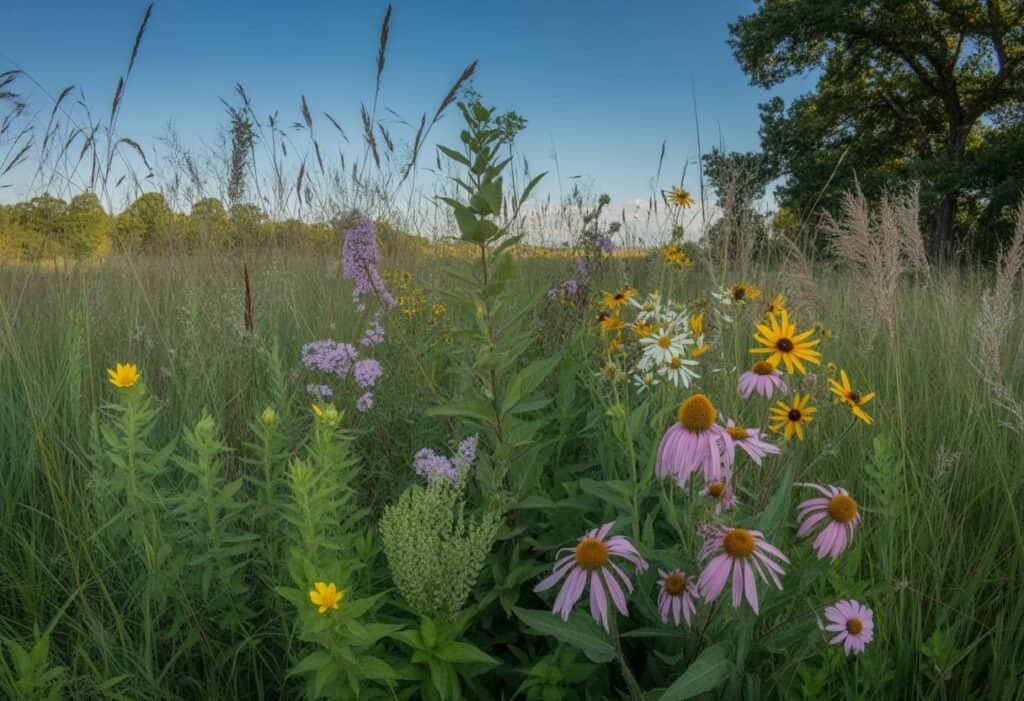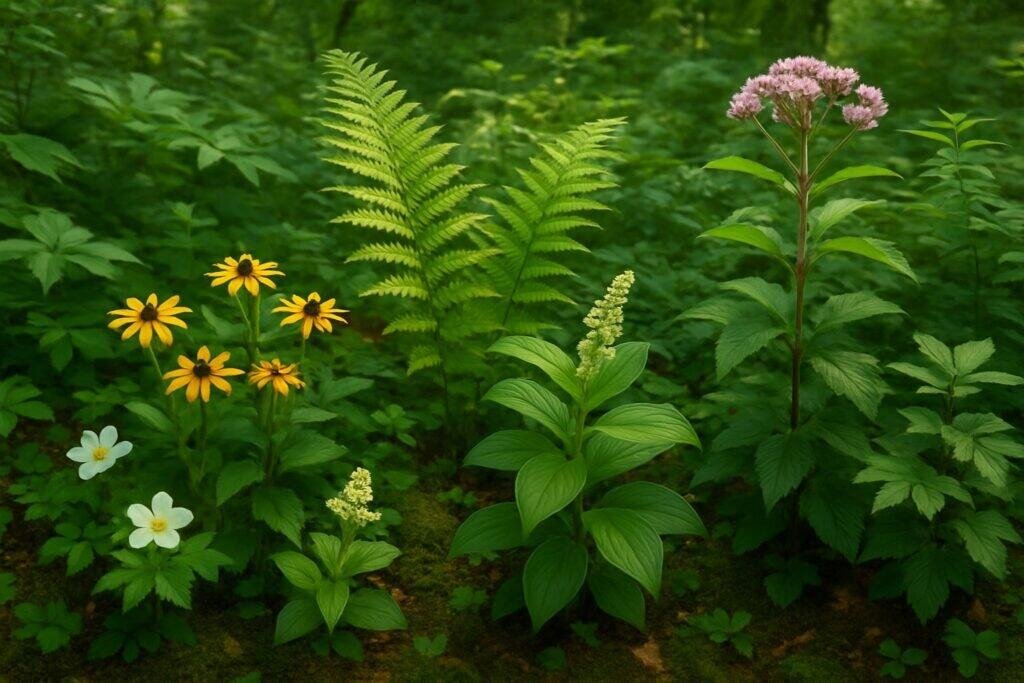Illinois native plants have thrived in our local soils and climate for thousands of years. They create diverse ecosystems that support local wildlife.
Growing native plants in your Illinois garden helps conserve water, reduce maintenance needs, and create habitat for pollinators and birds. These plants have evolved to handle our region’s harsh winters and hot summers. They are more resilient than non-native options.
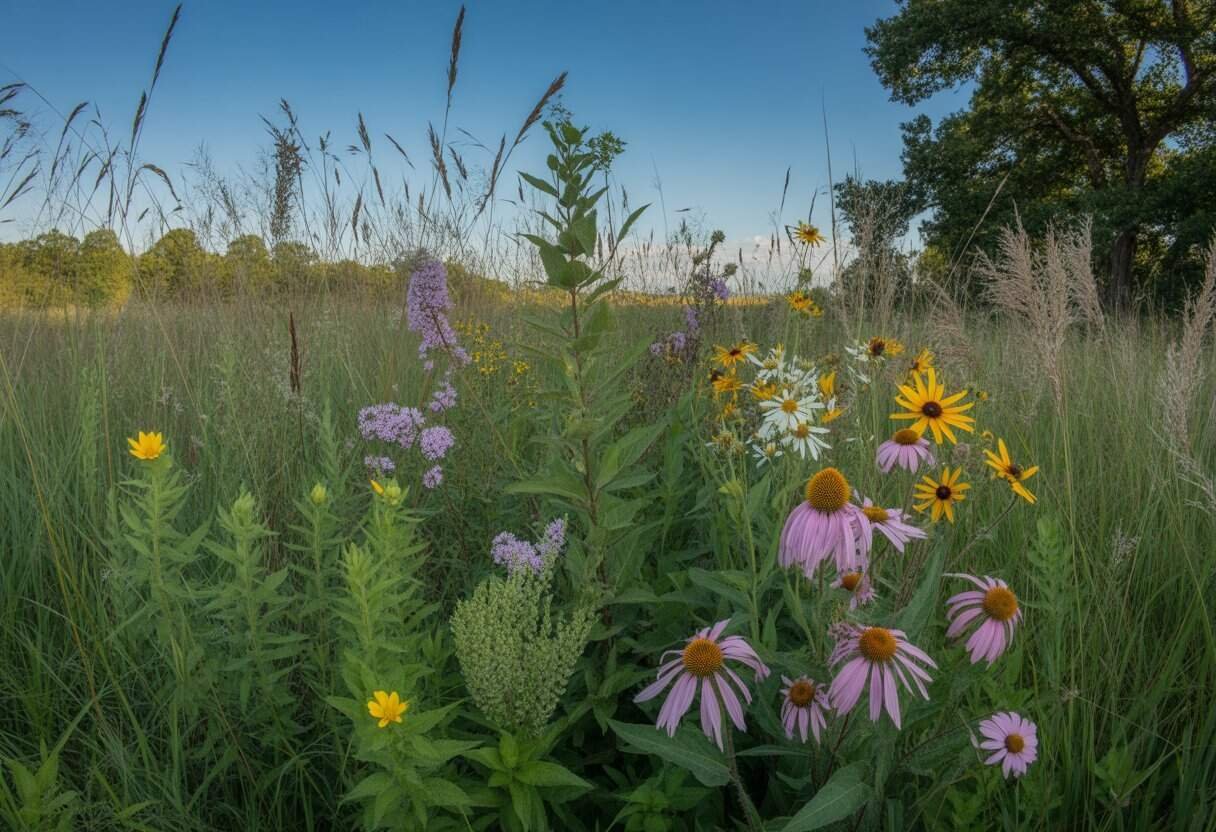
Whether you live in the prairie regions of central Illinois or the woodlands of the southern part of the state, you can find native plants suited to your specific growing conditions. From vibrant purple coneflowers to stately oak trees, Illinois natives offer beauty in every season and provide unique ecological benefits.
Key Takeaways
- Native Illinois plants require less water, fertilizer, and maintenance while supporting local wildlife.
- Prairie plants, woodland species, and wetland varieties represent the main native plant communities in Illinois.
- Local nurseries, native plant sales, and conservation organizations offer resources for adding Illinois natives to your landscape.
What Are Native Plants in Illinois?
Native plants in Illinois have evolved in the region over thousands of years. They have adapted to local soil, climate, and wildlife.
These plants create sustainable ecosystems and offer many benefits to both the environment and gardeners.
Defining Illinois Native Plants
Native plants in Illinois are species that existed in the region before European settlement. These plants evolved alongside local wildlife and developed complex relationships with pollinators, birds, and other animals.
Illinois native plants include trees like bur oak and shagbark hickory. Shrubs such as American hazelnut and wildflowers like purple coneflower and wild bergamot also belong to this group.
The state’s diverse ecosystems range from tallgrass prairies to woodlands and wetlands. Each environment hosts specific native plant communities adapted to those conditions.
Prairie plants often have deep root systems to survive drought and fire. Woodland natives thrive in partial shade beneath tree canopies.
Many Illinois native plants withstand local weather extremes. They need less maintenance once established because they’ve adapted to regional conditions over centuries.
Benefits of Growing Native Plants
Native plants provide practical advantages for Illinois gardeners and homeowners. They need less water than non-native species once established, which reduces maintenance and saves resources.
Their deep root systems prevent erosion and improve soil health. Illinois native plants offer essential habitat and food for local wildlife.
They support over 500 native bee species, many butterflies, and a variety of birds. Purple coneflower, for example, attracts both goldfinches and butterflies.
Key Environmental Benefits:
- Reduced need for fertilizers and pesticides
- Improved water quality through filtration
- Carbon sequestration in soil
- Increased biodiversity
Native plantings also connect people to Illinois’ natural heritage. They create a sense of place that reflects the region’s unique character.
Native Plants Versus Non-Native Species
Native plants differ from non-native species in their ecological roles and maintenance needs. Non-native plants often demand more water, fertilizer, and pest control.
Some non-native species become invasive and outcompete native plants. Illinois native plants have co-evolved with local insects and wildlife.
A native oak tree supports over 500 species of caterpillars, while a non-native ginkgo might host only a few. This difference impacts the entire food web, including birds that feed on those insects.
Non-native ornamentals may have showy flowers but usually offer little ecological value. For example, butterfly bush attracts pollinators but cannot serve as a host plant for butterfly larvae.
Native alternatives exist for almost every garden need. Instead of Japanese barberry, plant native ninebark. Rather than daylilies, choose native prairie blazing star for summer color.
Key Types of Native Plants in Illinois
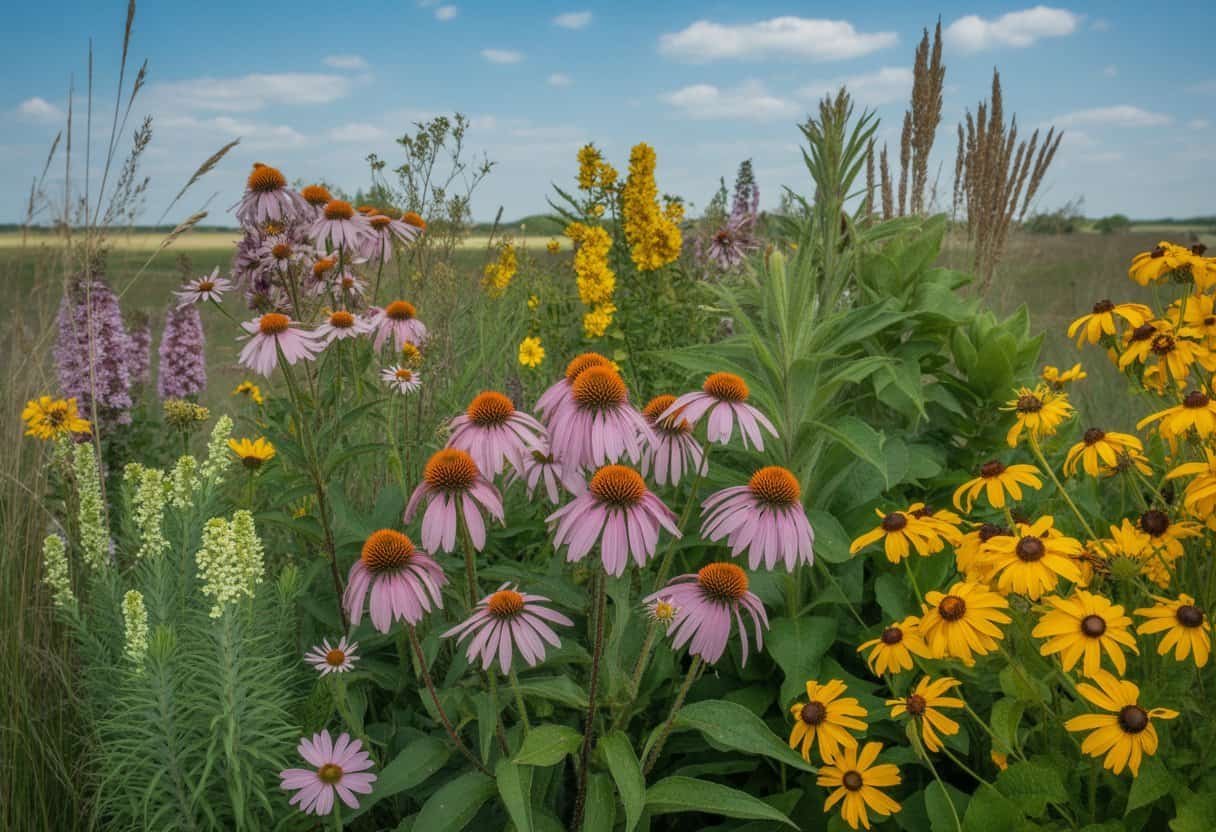
Illinois has a rich diversity of native plants that thrive in the state’s varied landscapes. These plants support local wildlife and need less maintenance than non-native species.
Wildflowers of Illinois
Purple prairie clover stands out among Illinois’ native wildflowers. Its vibrant purple blooms attract pollinators.
White snakeroot thrives in woodland edges and produces clusters of small white flowers in late summer. This plant contains toxins harmful to livestock.
Spiderwort displays striking blue-purple flowers that open in the morning and close by afternoon. These hardy perennials adapt to many soil conditions across Illinois.
Columbine has distinctive nodding flowers with red outer parts and yellow centers. It grows naturally in woodland areas and attracts hummingbirds.
Swamp milkweed supports monarch butterflies. Its pink flower clusters bloom in wet areas during summer.
Native Trees and Shrubs
River birch grows along waterways and features peeling bark in shades of salmon and cinnamon. This medium-sized tree provides habitat for birds and insects.
Box elder, a type of maple, grows quickly in various conditions. It has compound leaves and adapts to both wet and dry sites.
Downy serviceberry offers year-round interest with spring white flowers, summer berries, and vibrant fall colors. Birds eagerly eat its small fruits.
Oak trees dominate many Illinois ecosystems. White, red, and bur oaks support hundreds of insect species and produce acorns for wildlife.
Eastern redbud trees announce spring with bright pink-purple flowers that emerge directly from branches. They grow naturally as understory trees in woodlands.
Grasses and Groundcovers
Big bluestem, once common throughout Illinois prairies, can reach heights of 6-8 feet. Its “turkey foot” seed heads appear in late summer.
Little bluestem provides winter interest with its copper-red color. This bunch grass grows 2-3 feet tall and thrives in dry soils.
Prairie dropseed forms neat mounds of fine-textured foliage. Its delicate seedheads emit a unique fragrance some compare to popcorn or cilantro.
Wild ginger serves as a groundcover for shady woodland gardens. Its heart-shaped leaves create a dense mat and unusual flowers appear at ground level.
Pennsylvania sedge offers a native alternative to turf grass for shaded areas. This low-growing plant spreads slowly to form natural carpets beneath trees.
Native Plant Ecosystems and Habitats
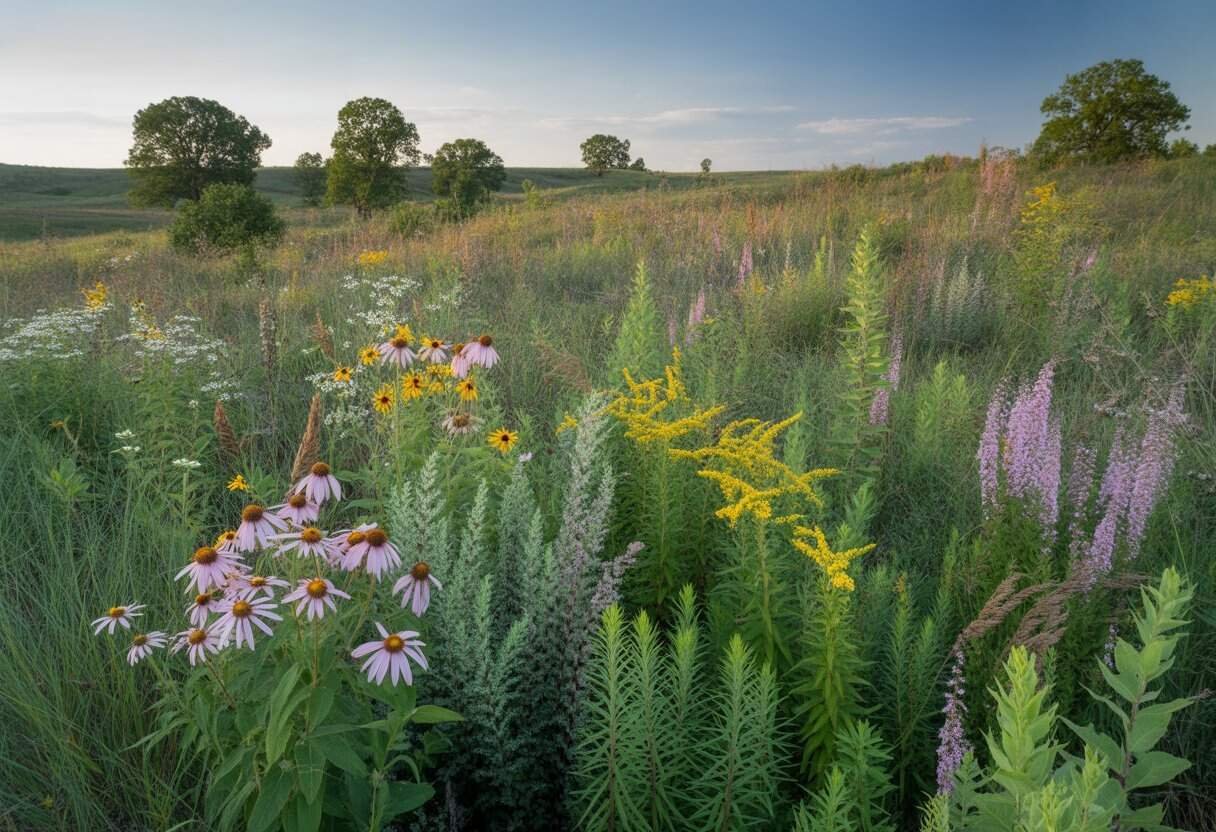
Illinois features diverse natural habitats that support unique native plant communities. These ecosystems have evolved over thousands of years and provide essential services for wildlife and people.
Prairies and Grasslands
Tallgrass prairies once covered about 60% of Illinois but now occupy less than 0.01% of their original area. These grasslands feature deep-rooted plants like big bluestem, which can reach heights of 6-8 feet and grow roots up to 12 feet deep.
Native prairie plants have adapted to Illinois’ harsh conditions. Common species include:
- Compass plant (Silphium laciniatum)
- Prairie blazing star (Liatris pycnostachya)
- Butterfly weed (Asclepias tuberosa)
These plants support diverse wildlife, from monarch butterflies to prairie chickens. Prairie ecosystems also prevent soil erosion and filter rainwater better than non-native landscapes.
Restoration projects in northeastern Illinois have reestablished prairie communities in forest preserves and parks.
Wetlands and Riparian Zones
Wetlands in Illinois include marshes, swamps, and floodplains. These areas serve as natural water filters and help control floods.
Northeastern Illinois contains significant wetland habitats despite urban development. These wetlands feature plants like:
- Blue flag iris (Iris virginica)
- Swamp milkweed (Asclepias incarnata)
- Cardinal flower (Lobelia cardinalis)
Riparian zones along rivers and streams create transition areas between water and land. These corridors support moisture-loving plants that stabilize banks and shade waterways.
Illinois has lost over 90% of its original wetlands. Conservation efforts focus on protecting remaining sites and restoring degraded wetlands to improve water quality and wildlife habitat.
Woodlands and Forests
Illinois woodlands range from open oak savannas to dense maple-beech forests. These ecosystems vary based on soil, moisture, and fire history.
Native trees like white oak (Quercus alba) and shagbark hickory (Carya ovata) create canopies for unique understory communities. Spring ephemeral wildflowers such as trillium and bloodroot bloom before trees leaf out.
Northeastern Illinois features oak woodlands that rely on periodic fire to stay open. Without fire, these habitats often become dense forests with fewer plant species.
Forest floor plants include:
- Wild ginger (Asarum canadense)
- Jack-in-the-pulpit (Arisaema triphyllum)
- Solomon’s seal (Polygonatum biflorum)
These woodland species provide food and habitat for birds, mammals, and insects.
How to Grow and Maintain Illinois Native Plants
Growing native Illinois plants requires techniques that match their natural growing conditions. These plants thrive when you plant them in suitable locations with proper soil preparation and regular maintenance to control weeds and pests.
Site Selection and Soil Preparation
Choose a location that matches the natural habitat of your selected native plants. Prairie plants need full sun for at least six hours a day, while woodland species prefer dappled shade.
Wetland natives need consistently moist soil. Test your soil before planting.
Most Illinois natives prefer well-draining soil with a pH between 5.5 and 7.0. Adding compost to clay soils improves drainage.
Clear the planting area of existing vegetation, especially aggressive non-native species. Thorough site preparation prevents future weed problems.
For prairie plantings, add a layer of weed-free topsoil mixed with sand to improve drainage. Woodland plants benefit from leaf compost that mimics forest floor conditions.
Planting Techniques and Best Practices
Plant in spring or fall when temperatures are mild and rainfall is reliable. Space plants according to their mature size to prevent overcrowding.
For seedlings, dig holes twice as wide as the root ball but no deeper. Place plants at the same depth they grew in their containers and water thoroughly after planting.
Seeds vs. Plants:
- Seeds: Less expensive for large areas
- Plants: Quicker results and higher success rate
Many native seeds need cold stratification (exposure to winter conditions) to germinate. You can achieve this by planting in fall or chilling seeds in the refrigerator.
Apply 2-3 inches of mulch around new plantings to retain moisture and suppress weeds. Use leaf mulch for woodland plants and straw for prairie species.
Managing Pests, Weeds, and Herbicides
Regular weeding during the first 2-3 years is crucial. Young native plants often grow slowly while weeds establish quickly.
Use targeted weed control. Hand-pulling works for small areas, while careful spot-treatment with herbicides helps manage larger infestations.
When using herbicides, choose products designed for the target weeds. Apply glyphosate carefully to avoid harming native plants and always follow label instructions.
Native plants usually have fewer pest problems than non-natives. Allow some insect feeding, as this supports local food webs and attracts beneficial insects.
Controlled burns can benefit prairie plantings but should only be done with proper permits and safety measures.
Creating Specialized Native Plant Gardens
Native plants can be arranged in specialized gardens that serve specific purposes in your Illinois landscape. These focused garden types attract wildlife, manage water, and create beauty using plants adapted to the Illinois climate.
Butterfly Gardens
Butterfly gardens attract these beautiful insects through careful plant selection. Include nectar plants for adult butterflies and host plants for caterpillars.
Key nectar plants include purple coneflower, black-eyed Susan, and blazing star. These plants provide food for adult butterflies throughout the growing season.
For caterpillars, milkweed is essential for monarchs. Violets host fritillary butterflies, and black cherry trees support eastern tiger swallowtail caterpillars.
Plant in sunny locations with some shelter from strong winds. Butterflies need warm spots to bask in the sun.
Avoid using pesticides in butterfly gardens because they harm both adults and caterpillars.
Rain Gardens
Rain gardens capture and filter stormwater. They help prevent erosion and runoff in low areas where water naturally collects.
Good locations for rain gardens:
- Areas downhill from downspouts
- Low spots in the yard
- Places where water pools after rain
Choose native plants with deep roots that tolerate both wet and dry conditions. Cardinal flower, blue flag iris, and fox sedge thrive in these settings.
Dig the garden 4-8 inches deep with a slight depression in the center. This shape helps collect water during rainfall.
Add a layer of mulch to prevent erosion until plants establish. After a few years, established plants will maintain the garden with little care.
Pollinator-Friendly Spaces
Pollinator gardens support bees, butterflies, and other beneficial insects. These gardens should bloom throughout the growing season.
Spring bloomers: Wild geranium, Jacob’s ladder, and shooting star
Summer bloomers: Bee balm, black-eyed Susan, and purple prairie clover
Fall bloomers: New England aster, goldenrod, and bottle gentian
Plant in groups of at least three of the same species. This helps pollinators find and collect pollen more easily.
Include a shallow water source like a bird bath with rocks for insects to land on. Clean and refill it regularly.
Leave some bare soil patches for ground-nesting bees. Let some hollow stems remain standing in winter as bee habitat.
Where to Find and Purchase Illinois Native Plants
Finding quality native plants for your Illinois garden is easier than ever. Several nurseries and seasonal events offer a wide selection of locally adapted species.
Local Plant Nurseries
Many specialized nurseries across Illinois focus on native plants. Possibility Place Nursery in Monee offers an extensive selection of Illinois prairie and woodland species.
Prairie Moon Nursery provides both plants and seeds, with detailed growing information for each species. Natural Gardens in St. Charles specializes in native perennials and grasses for home landscapes.
The Growing Place in Naperville and Aurora features native plant sections with knowledgeable staff to help beginners.
These nurseries typically offer:
- Perennial wildflowers
- Native grasses
- Woodland species
- Prairie plants
- Shrubs and trees native to Illinois
Most provide online catalogs where you can browse their inventory before visiting. Call ahead to confirm availability of specific plants, as stock changes seasonally.
Native Plant Sales and Events
Seasonal plant sales give you a chance to purchase native plants while supporting conservation groups. The Illinois Native Plant Society hosts regional plant sales each spring, featuring locally grown specimens and expert advice.
Many forest preserves and conservation districts organize annual native plant sales:
- Chicago Botanic Garden’s Native Plant Sale (May)
- DuPage County Forest Preserve’s Native Plant Sale (April)
- Lake County Forest Preserves’ Native Plant Sale (June)
University of Illinois Extension offices often host one-day plant sales with master gardeners available to answer questions. Arrive early, as these events often sell out quickly.
Local garden clubs and environmental organizations may organize smaller sales throughout the growing season. Follow these groups on social media for updates on events and available plant selections.
Conservation and Community Involvement
Protecting Illinois’ native plants requires efforts from organizations and everyday citizens. Community involvement plays a crucial role in preserving our natural heritage.
Role of Conservation in Native Plant Survival
Native plant conservation in Illinois faces challenges from habitat loss and invasive species. Development has reduced natural areas to less than 0.01% of their original extent in some regions.
Conservation efforts protect remaining natural areas through land acquisition and management. Organizations like the Illinois Department of Natural Resources maintain nature preserves where native plants can thrive.
Seed banks store seeds from rare and endangered native plants. These facilities help prevent extinction and support restoration projects.
Key Conservation Strategies:
- Habitat restoration in degraded areas
- Removal of invasive species that compete with natives
- Prescribed burns that mimic natural processes
- Education programs to increase public awareness
Volunteer monitoring programs track plant populations and identify areas needing protection.
Supporting the Illinois Native Plant Society
The Illinois Native Plant Society (INPS) leads efforts to preserve and study native plants and their habitats. Founded in 1982, this organization operates through regional chapters across the state.
INPS offers many ways for individuals to get involved:
- Plant Sales: Purchase locally grown native plants for your garden
- Field Trips: Explore natural areas with knowledgeable guides
- Workshops: Learn plant identification and gardening techniques
- Volunteer Opportunities: Help with restoration projects
Members receive “The Harbinger” newsletter with information about native plants and upcoming events. The society also publishes research and maintains a comprehensive database of Illinois native plants.
Annual membership fees support conservation and education programs. Many INPS activities are open to the public, even for non-members.
Frequently Asked Questions
Illinois native plants offer many benefits for home gardens and local ecosystems. These plants have adapted to local conditions over thousands of years, making them well-suited for Illinois landscapes.
What are the best Illinois native plants for landscaping purposes?
Several Illinois native plants excel in landscaping. Purple coneflower (Echinacea purpurea) attracts pollinators and requires little care once established.
Wild bergamot (Monarda fistulosa) produces lavender blooms that attract butterflies and hummingbirds. It grows well in average to dry soil.
Black-eyed Susan (Rudbeckia hirta) provides vibrant yellow flowers from June through September. This drought-tolerant plant works well in borders and wildflower gardens.
Where can I find a nursery that sells native plants from Illinois?
Possibility Place Nursery in Monee specializes in Illinois native plants and offers a wide selection of trees, shrubs, and perennials.
Natural Garden Natives in St. Charles provides many prairie and woodland species native to the region. They offer both retail and wholesale options.
The Growing Place in Naperville and Aurora stocks many Illinois natives alongside gardening supplies and expert advice.
How can I identify various native plants found in Illinois?
The Illinois Wildflowers website provides detailed descriptions and photographs of hundreds of native plant species organized by habitat.
Field guides like “Plants of the Chicago Region” by Swink and Wilhelm offer comprehensive information about local plant communities.
The iNaturalist app lets users photograph plants and get identification help from both artificial intelligence and human experts.
Where can I view images of native plant species indigenous to Illinois?
The Illinois Department of Natural Resources website features a photo gallery of common native plants organized by type and habitat.
The Morton Arboretum’s online plant database includes high-quality images of Illinois natives in different seasons and growth stages.
Prairie Moon Nursery’s website displays detailed photographs of native plants at various life stages, helping gardeners see mature specimens.
Are there any comprehensive guides or PDFs available on Illinois native plants?
The Illinois Native Plant Guide by the Illinois Department of Natural Resources offers detailed information about selecting and growing native species. This free PDF includes planting instructions and maintenance tips.
“Native Plants in the Home Landscape” from University of Illinois Extension provides region-specific guidance for home gardeners.
The Chicago Botanic Garden offers several downloadable plant lists and care guides focused on Illinois native species for different garden situations.
What perennial flowers are native to Illinois and suitable for gardens?
Butterfly weed (Asclepias tuberosa) produces bright orange flowers that attract monarchs and other butterflies. This drought-tolerant plant thrives in sunny locations.
Cardinal flower (Lobelia cardinalis) displays striking red blooms that attract hummingbirds. It prefers moist soil and partial shade.
Prairie blazing star (Liatris pycnostachya) features tall purple flower spikes that bloom in mid to late summer. This plant attracts many pollinators and adds visual interest.

